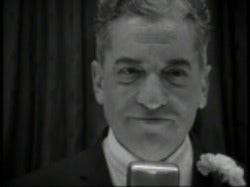In 1967, Frederick Wiseman went to a state hospital in Massachusetts with a movie camera and watched what went on within the walls of the institution. When he finished watching, Fred went home and cut together a documentary called “Titicut Follies.”
 The result proved so damning a portrait of official malfeasance, neglect and incompetence that the state of Massachusetts fought successfully against its public release for over 20 years. Ever since “Titicut,” Fred’s unblinking documentarian’s eye has fixed on a wide array of other institutions and issues, from high schools to domestic violence, from boxers to ballet dancers.
The result proved so damning a portrait of official malfeasance, neglect and incompetence that the state of Massachusetts fought successfully against its public release for over 20 years. Ever since “Titicut,” Fred’s unblinking documentarian’s eye has fixed on a wide array of other institutions and issues, from high schools to domestic violence, from boxers to ballet dancers.
His extraordinary body of work inspired Loyola Marymount University’s School of Film and Television, where I am dean, to honor him this week with a Lifetime Achievement Award as part of our Film Outside the Frame festival. It’s a richly deserved honor.
Fred’s work, aired over the years on PBS, has been one of the principal reasons public broadcasting acquired its reputation for excellence in the documentary field. His approach has largely remained the same since the beginning: he chooses a topic or institution, exhaustively films hundreds of hours of material over several months, then figures out a compelling, organic dramatic structure in the editing process.
His old-school approach is so unadorned it might seem antediluvian, unless you realize how truly hip and modern it is. He uses no narrative voiceover, no explanatory interviews, no background music, no fictional devices, no visual effects. What the camera captures is what the documentary shows.
That said, Fred’s classic lecture on visual literacy (which he will give again this Friday at Loyola) will make it clear that he is “not a fly on the wall or anywhere else.” He picks the right 70 or 80 or 90 minutes out of 100 hours of film, then subtly shapes and directs a powerful story.
He always takes a position, but does it in such a skillful way that you aren’t necessarily conscious of it. I would submit that approach is a much more difficult challenge than the “in your face” position-taking used by many popular doc makers these days
I must also confess that in the early 1970s, when I was teaching at Brandeis University and Franconia College and making political docs, I didn’t appreciate his more subtle approach. I was wrong. It turns out that his approach has weathered the years far better than the more didactic work of that era.
And the approach remains influential. Nicolas Philibert’s brilliant 2002 documentary about a small French school, “To Be and to Have,” (“Etre et Avoir”) owes a clear debt to Fred’s iconic “High School,” a 1968 film that could have been shot, with relatively few changes, last year.
For that matter, Fred himself has weathered the years well. Now 80, he continues to create remarkable work, as with 2009’s “La Danse – Le Ballet de L’Opera de Paris,” which we are screening Monday night on campus. And his “Not a Fly” lecture on Friday had to be moved to mid-afternoon so he could sandwich it between two shoots for his next project.
Fred, an attorney by training, also has been a pioneer in another way: as a savvy businessperson who kept control of his projects. In a field known for creative types who don’t pay attention to the business end of their projects, Fred stands out. He started Zipporah Films in 1970 to keep tight control over his films’ distribution, and he continues to do so to this day.
I hope by having Fred on campus and at the Film Outside the Frame Festival that we can inspire students to make better films, make a difference in society, and make sure their films thrive financially too. Fred has done all three for more than 40 years, and we are honored that we can mark his lifelong achievements this week.

